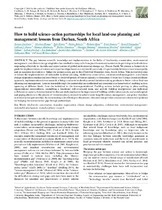| dc.contributor.author | Cockburn, Jessica | |
| dc.contributor.author | Rouget, Mathieu | |
| dc.contributor.author | Smit, Albertus J | |
| dc.date.accessioned | 2021-09-15T11:54:08Z | |
| dc.date.available | 2021-09-15T11:54:08Z | |
| dc.date.issued | 2016 | |
| dc.identifier.citation | Cockburn, J. et al. (2016). How to build science-action partnerships for local land-use planning and management: Lessons from Durban, South Africa. Ecology and Society, 21(1),28. https://doi.org/10.5751/ES-08109-210128 | en_US |
| dc.identifier.issn | 1708-3087 | |
| dc.identifier.uri | http://www.ecologyandsociety.org/vol21/iss1/art28/ | |
| dc.identifier.uri | http://hdl.handle.net/10566/6685 | |
| dc.description.abstract | The gap between scientific knowledge and implementation in the fields of biodiversity conservation, environmental
management, and climate change adaptation has resulted in many calls from practitioners and academics to provide practical solutions
responding effectively to the risks and opportunities of global environmental change, e.g., Future Earth. We present a framework to
guide the implementation of science-action partnerships based on a real-world case study of a partnership between a local municipality
and an academic institution to bridge the science-action gap in the eThekwini Municipal Area, South Africa. This partnership aims
to inform the implementation of sustainable land-use planning, biodiversity conservation, environmental management, and climate
change adaptation practice and contributes to the development of human capacity in these areas of expertise. Using a transdisciplinary
approach, implementation-driven research is being conducted to develop several decision-making products to better inform land-use
planning and management. Lessons learned through this partnership are synthesized and presented as a framework of enabling actions
operating at different levels, from the individual to the interorganizational. Enabling actions include putting in place enabling
organizational preconditions, assembling a functional well-structured team, and actively building interpersonal and individual
collaborative capacity. Lessons learned in the case study emphasize the importance of building collaborative capacity and social capital,
and paying attention to the process of transdisciplinary research to achieve more tangible science, management, and policy objectives
in science-action partnerships. By documenting and reflecting on the process, this case study provides conceptual and practical guidance
on bridging the science-action gap through partnerships. | en_US |
| dc.language.iso | en | en_US |
| dc.publisher | Resilience Alliance | en_US |
| dc.subject | Biodiversity conservation | en_US |
| dc.subject | Climate change adaptation | en_US |
| dc.subject | Environmental management | en_US |
| dc.subject | Sustainable development | en_US |
| dc.subject | South Africa | en_US |
| dc.title | How to build science-action partnerships for local land-use planning and management: Lessons from Durban, South Africa | en_US |
| dc.type | Article | en_US |

